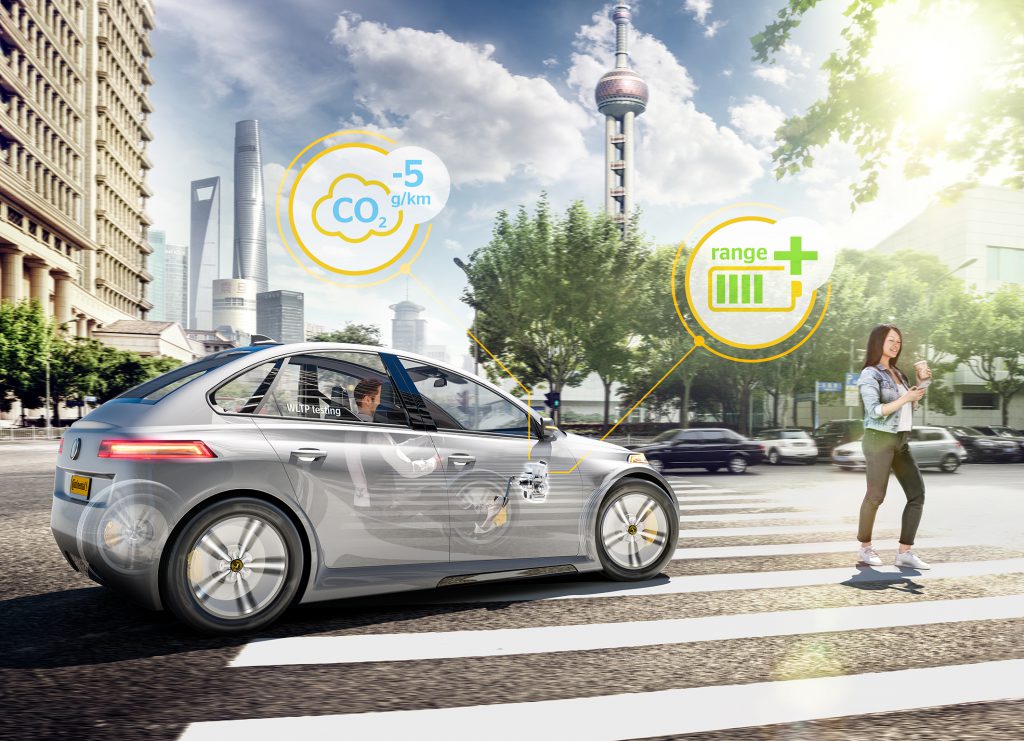This post is also available in: German
- Savings of regenerative energy due to improved utilization of the achievable recuperation potential
- Tests of the CO2 savings potential of the MK C1 electrohydraulic brake system in a plug-in hybrid
- TÜV confirms in a certified test: MK C1 reduces the amount of CO2 emitted in the WLTP by around 5 g/km on average compared with a conventional hydraulic hybrid brake system
- Start of production for the MK C1 in China scheduled for the end of 2020
Frankfurt/Shanghai, April 16, 2019. When it comes to the CO2 emissions of cars, the clock is ticking ever louder: In the EU, newly registered vehicles from a manufacturer’s fleet will be allowed to emit only 95 g of carbon dioxide (CO2) per kilometer on average from as early as 2021. Every gram of CO2 over the limit will cost manufacturers €95 – and that figure then has to be multiplied by the number of vehicles sold. Against the backdrop of stricter CO2 legislation around the world, the focus right now is on reducing emissions gram by gram. In the U.S.A., a maximum of only 121 g/km has been stipulated by 2020. This figure is 117 g/km in China and 105 g/km in Japan. Besides the powertrain, other vehicle systems are required to play their part in emissions reduction, such as the brake system. At the Auto Shanghai in China (April 16 to 25, 2019), the technology company Continental will present the results of a recent TÜV-certified test. “Here, the MK C1 electrohydraulic brake-by-wire brake system, installed in a standard plug-in hybrid vehicle from the D-segment class, reduced CO2 emissions by around 5 g/km on average compared with a conventional – non-brake-by-wire – hybrid brake system,” said Matthias Matic, head of the Vehicle Dynamics business unit of the Chassis & Safety division at Continental.

WLTP confirms CO2 reduction
The measurements were taken on a dynamometer test in accordance with the WLTP (Worldwide harmonized Light vehicle Test Procedure), the globally valid measurement procedure for determining the exhaust emissions and fuel/electricity consumption of motor vehicles, and were supervised by the TÜV experts present. During each of the three test runs, the vehicle with the MK C1 recovered 160 Wh of additional electrical energy on average in the deceleration phases of the individual cycle – around 32 percent more than the system in comparison. The MK C1 makes this possible by enabling consistent use of the electric motor as a generator during braking. The intelligent hybrid control can then use the additional electricity generated in this way for fuel-efficient driving, thereby reducing CO2 emissions and fuel consumption.
“For the efficiency of a hybrid vehicle, it is important to use up as little of the vehicle’s kinetic energy as possible on the wheel brakes, because this energy is lost. Our MK C1 brake-by-wire brake system enables full utilization of the recuperation potential. This allows the vehicle to recover more electricity and achieve measurable CO2 savings,” said Matic. “At the end of 2020, we will begin production of the MK C1 in Shanghai for a Chinese customer. We are therefore following our strategy of producing in the market, for the market.” The MK C1 has already been manufactured in series production for the European market in Frankfurt am Main since 2016, and for the American market in Morganton, North Carolina, U.S.A., since 2019.
Recuperation without compromise

In a hybrid vehicle, the seamless transition (brake blending) from regenerative braking (recuperation) to mechanical friction brakes is subject to limitations. The problem with a conventional hybrid brake system, complete with tandem main cylinder, brake booster and control system as separate main components, lies in the lack of pedal decoupling. This is also the case in the plug-in hybrid tested: “Here, recuperation potential is also thrown away in the series configuration. By contrast, the brake pedal in the MK C1 is usually completely decoupled from pressure generation. Therefore the driver always has a uniform pedal feel. The full use can be made of recuperation phases – saving CO2 as a result,” said Marcus Bletz, senior expert in regenerative braking in the Vehicle Dynamics business unit.
Efficiency and dynamism in a single module
Calculated for an electric vehicle with an energy consumption of 18 kWh/100 km, the increase in the efficiency of the MK C1 documented in the test alone would equate to a 4 percent increase in range based on a 500-kilometer route – in other words, almost 20 kilometers. At the same time, the MK C1 has safety advantages: The electromechanically generated full brake pressure reached within 150 ms, allowing advanced driver assistance systems or automated vehicles to be brought to a standstill more quickly from a higher speed without driver intervention than in the case of conventional brake systems.
“This provides a longer time frame in which an automatic emergency braking function can detect an obstacle with absolute certainty and nevertheless initiate autonomous emergency braking successfully,” said Jürgen Woywod, head of Vehicle System Integration in the Vehicle Dynamics business unit. “Efficiency and safety go hand in hand with the MK C1. This electrohydraulic brake system is therefore perfectly suited for the global trends of electrification and automation.”
Press contact
Miriam Baum
External Communications
Chassis & Safety Division
Continental
Phone: +49 69 7603 9510
E-Mail: miriam.baum@continental.com
Sören Pinkow
External Communications
Chassis & Safety Division
Continental
Phone: +49 69 7603 8492
E-Mail: soeren.pinkow@continental.com



